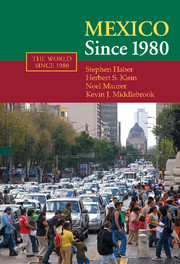Book contents
- Frontmatter
- Contents
- List of Figures
- Acknowledgments
- Abbreviations and Acronyms
- 1 The Second Mexican Revolution: Economic, Political, and Social Change Since 1980
- 2 Mexico Before 1982: The Political Economy of Authoritarian Rule
- 3 The Causes and Consequences of Free Trade
- 4 The Mexican Banking System: The Politics and Economics of Financial Underdevelopment
- 5 The Transformation of Mexican Politics
- 6 Health, Education, and Welfare in Mexico Since 1980
- 7 Democracy and Development in Mexico: Future Challenges and the Legacies of Authoritarian Rule
- Bibliography
- Index
1 - The Second Mexican Revolution: Economic, Political, and Social Change Since 1980
Published online by Cambridge University Press: 05 September 2012
- Frontmatter
- Contents
- List of Figures
- Acknowledgments
- Abbreviations and Acronyms
- 1 The Second Mexican Revolution: Economic, Political, and Social Change Since 1980
- 2 Mexico Before 1982: The Political Economy of Authoritarian Rule
- 3 The Causes and Consequences of Free Trade
- 4 The Mexican Banking System: The Politics and Economics of Financial Underdevelopment
- 5 The Transformation of Mexican Politics
- 6 Health, Education, and Welfare in Mexico Since 1980
- 7 Democracy and Development in Mexico: Future Challenges and the Legacies of Authoritarian Rule
- Bibliography
- Index
Summary
This book is about a revolution – albeit an incomplete one. It had none of the features that political analysts typically associate with revolutions: no organized violence, no overturning of the social class structure, and no defeated dictator fleeing into exile. Nevertheless, if by “revolution” we mean a dramatic change in the institutions that organize economic, political, and social life, then Mexico has undoubtedly been in the midst of a revolution since the early 1980s.
In 1980, Mexico was largely closed to foreign trade and investment; government-owned firms controlled a substantial portion of the economy. An “official” party, the Institutional Revolutionary Party (PRI), held a virtual monopoly on political power. Since its creation in 1929, Mexico's government-supported party had won every presidential, gubernatorial, and senatorial election. To maintain a façade of democracy, PRI-led administrations crafted a complex set of electoral rules that allowed other parties, some of which were actually subsidized by the government, to win seats in the federal Chamber of Deputies (Mexico's lower house of congress). The PRI, however, always dominated this chamber by an overwhelming majority. The PRI used its electoral dominance to maintain control over Mexico's regulatory and legal systems: PRI-affiliated government officials named state and federal judges and the directors of government-owned firms as well as making appointments in the federal bureaucracy.
- Type
- Chapter
- Information
- Mexico since 1980 , pp. 1 - 19Publisher: Cambridge University PressPrint publication year: 2008



